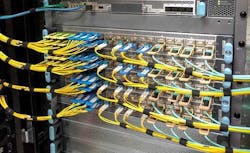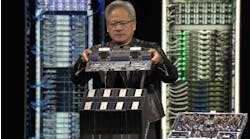The way William Charnock sees it, the rise of cloud computing changed the way customers think about IT infrastructure. By allowing users to quickly provision compute capacity through an online portal, the cloud made it inevitable that this on-demand paradigm would come to the network.
“We witnessed this evolution in how people started using compute as a service,” said Charnock, the CEO and co-founder of PacketFabric. “On-demand was a revolutionary idea. We felt networking would be next, and we could automate things. We set out to build a software-defined carrier network, with new consumption models.”
PacketFabric is among a group of startups bringing the power of software-defined networking (SDN) to multi-tenant data centers, disrupting the way connectivity is bought and provisioned. These companies – which include Megaport, PacketFabric and Console – provide network capacity that can be configured through a web portal, dramatically simplifying the way data center customers manage their connectivity.
These services are emerging as key players in the data center ecosystem, as seen in the steady stream of service providers announcing business ties with these companies.
The latest example is today’s announcement from EdgeConneX, which will deploy PacketFabric’s technology at data centers in Phoenix, Portland, Minneapolis and Santa Clara. “This partnership will enable EdgeConneX to provide tenants with instantaneous access to PacketFabric’s extensive transcontinental network,” said Clint Heiden, Chief Commercial Office at EdgeConneX, which operates a national network of edge data centers.
How SDN Works
Software-Defined Networking (SDN) separates the programming of routers and switches from the underlying hardware, simplifying the management of networks. By using software controllers to move configuration off the device, SDN allows administrators to automate many network functions, and dynamically manage their network operations.
SDN had its initial impact at hyperscale data centers, who were among the early supporters of new protocols like OpenFlow that allowed them to manage network gear using external servers, rather than proprietary software running on the switch itself.
It took a while for this trend to make its way into multi-tenant data centers, where network configuration has historically been a lengthy process involving requests for proposal, long-term contracts, complex pricing and significant lead time before a physical network connection is made to launch the service. SDN has allowed the creation of virtual circuits, which are now being adapted to provide virtual cross connects and virtual interconnection, expanding SDN’s benefits to a larger pool of users.[clickToTweet tweet=”Will Charnock: We can provision transport in seconds. From a service delivery standpoint, it’s pretty revolutionary. ” quote=”Will Charnock: We can provision transport in seconds. From a service delivery standpoint, it’s pretty revolutionary. “]
“What we offer is the ability for customers to go on our web site and order capacity,” said Charnock. “From a service delivery standpoint, it’s pretty revolutionary. We can now provision transport in seconds, and we give customers the option to pay only for what they use.”
Users can buy capacity on a month-to-month basis, or do longer term contracts in exchange for discounts on term. It makes it easier to provision connections to cloud service providers, but also to create an elastic network that can scale up and down, matching capacity and spending to the requirements of the business. This elastic provisioning, and the cost control it provides, has been a key driver in the rapid growth of cloud computing.
“I think we’re highly disruptive to the traditional carrier model,” said Charnock. “We put a new level of control in the customers’ hands that they’ve never had before. What we’re trying to do is take the complexity of interconnection and network connectivity out of the picture.”
The Major Players
The data center SDN connectivity providers are relatively new companies, but their leadership teams are packed with industry veterans, and several are backed by investors with deep pockets.
- Megaport: This Australian company was founded by serial entrepreneur Bevan Slattery, who previously founded the telco PIPE Networks and data center provider NEXTDC. Megaport was launched in 2013 as a dark fiber provider, but soon shifted its focus to the interconnection market, and spun off the fiber assets as Superloop. Megaport went public with an IPO on the Australian Stock Exchange in November 2015, and has used the proceeds to expand its SDN connectivity services into the U.S. market. One of its early customer wins was Digital Realty, which uses Megaport to power Service Exchange, which allows Digital Realty customers to privately connect with popular clouds and services, including both Infrastructure as a Service IaaS clouds like Amazon Web Services, as well as SaaS offerings like Office365. It has since added relationships with CyrusOne, Internap, Rackspace, Data Foundry, QTS Data Centers and Stream Data Centers.
- Console: Launched in 2011 as IIX, Console was founded by Al Burgio to develop a “Software Defined Interconnect” model to manage networks via a web portal. Console is a privately-held, venture-backed company whose investors include New Enterprise Associates and AME Cloud Ventures. The company unveiled its Console Connect platform in 2015 to provide a Software-as-a-Service model. The company has 170 nodes (Point of Presence) across the globe. It has relationships with data center providers including T5 Data Centers, Zayo Group, vXchange, Cologix, RagingWire, Peak 10 and IO.
- PacketFabric: The newest of the multi-tenant SDN players was launched in January with backing from NantWorks, the technology conglomerate created by Dr. Patrick Soon-Shiong, the billionaire entrepreneur and inventor. Soon-Shiong, who has founded and sold several healthcare companies, created NantWorks as an umbrella for innovative tech startups. PacketFabric built the network infrastructure and SDN software to support NantWorks’ data-centric operations, and is now offering network services to data center providers, including Telehouse, Infomart, Netrality, Sabey, QTS, ColoATL and EdgeConneX, as well as Internet exchange providers AMS-IX and DE-CIX. PacketFabric now has connectivity into 145 data center facilities across 17 U.S. markets.
These companies have arrived on the scene as interconnection is becoming more important in the data center business. The emergence of simplified networking offers potential upside for service providers hoping to narrow the competitive gap with Equinix, the largest colocation provider and clear leader in interconnection services. Equinix has its own SDN-powered service, known as Cloud Exchange. But the ability to improve interconnection offerings – including the ability to easily tie into Equinix’s network-dense traffic hubs – has been embraced by data center providers.
These relationships aren’t always simple, as service providers have taken a range of approaches to their network offerings, which bear on how they use services like PacketFabric.
“We have a lot of data center partners,” said Jezzibell Gilmore, a co-founder and Senior VP of Business Development at PacketFabric. “With some we have a strict vendor relationship, while in other cases we are partners. They offer us space and power and we work with them to build a data center ecosystem. PacketFabric becomes a draw for new customers.”
What’s clear is that the explosion of data-intensive technologies like artificial intelligence, “Big Data” analytics, virtual reality and autonomous cars are making the network more important than ever. From a data center perspective, this rising tide of data can float many boats, and SDN connectivity providers are positioned to spread the opportunity around.
Network Infrastructure Seen as Differentiator
Gilmore and Charnock founded the company along with Chief Technology Officer Richard Steenbergen and Anna Claiborne,the Senior VP of Software Engineering. Charnock was an executive at ThePlanet and SoftLayer, while Gilmore and Steenbergen are veterans of GTT Communications, and Claiborne co-founded Prolexic and also has experience at Terremark.
All the SDN providers cite differentiators that separate them from the competition. For PacketFabric, it’s network infrastructure.
“We’re a little different in that we own the underlying network,” said Charnock, who said PacketFabric owns dark fiber metro rings connecting key data centers in a market. Charnock says the scale of PacketFabric’s infrastructure is useful to larger customers.
“Our platform is one to any,” he said. “When you access the fabric, you have access to anyone else who connects to the fabric. If you have multiple data centers you want to connect, it makes it easy to tie them together.”
Like other executives in the SDN ecosystem, Charnock has lived through an era in which data center networking was complex and frustrating. Charnock believes PacketFabric, and companies like it, are ushering in a new era in network services.
“We’re very early right now, and that’s good,” said Charnock. “It’s an exciting place to be. Many consumers of the cloud get the idea, and will accept similar models.”
Data center providers are seeing the value these companies provide, as well as the potential for further change ahead.
“We have incorporated them as an added value to our customers,” said Rodney Settles, Global Account Manager at Telehouse. “It gives the end user a better experience and much more control over their environment.”
“These companies are disruptive and absolutely necessary,” said Dan Meltzer, Vice President of Sales & Leasing at Sabey Data Centers. “I think they’ll be important going forward.”






